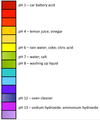SATs - Higher Flashcards
(165 cards)
What are the 7 life processes (and how can you remember these)?
Movement
Respiration
Sensitivity
Nutrition
Excretion
Reproduction
Growth
(Mrs Nerg)
Draw and label an animal cell

Draw and label a plant cell

What do the following parts of the cell do: -
Nucleus
Cytoplasm
Cell membrane
Cell wall
Vacuole
Chloroplast
Nucleus – controls the cell (containing DNA)
Cytoplasm – where chemical reactions take place
Cell membrane – controls what enters and leaves the cell
Cell wall – keeps the shape of the cell
Vacuole – contains cell sap, stores water and minerals & helps in cell structure
Chloroplasts – contains the chlorophyll which traps the sunlight needed for photosynthesis
What parts of the cell are found in both plants and animals?
What parts are only found in plants?
Cell membrane, cytoplasm & nucleus
Plant only – chloroplasts, cell wall & vacuole
Draw a picture of the following and explain how they are specialised: -
Sperm cell
Ovum (egg) cell

Draw a picture of the following and explain how they are specialised: -
Palisade cell
Root-hair cell

Draw a picture of the following and explain how they are specialised: -
Cilia cell
Red blood cell

Which systems are the following organs part of: -
Stomach
Lungs
Bladder
Ovary
Brain
Pancreas
Ankle bone
Bicep muscle
Stomach – digestive
Lungs – breathing
Bladder – urinary
Ovary – reproductive
Brain – sensory
Pancreas – endocrine
Ankle bone – skeletal
Bicep muscle - muscular
What are the 7 things needed for a healthy diet?
Carbohydrates
Fats
Proteins
Fibre
Vitamins
Minerals
Water
How do you test for the following foods: -
Starch
Protein
Simple sugars (e.g. glucose)
Starch – add iodine (brown → black)
Protein – add Biuret solution (blue → purple)
Sugar – add Benedicts (blue → orange)
Label the digestive system below: -


What are the jobs of the following parts of the digestive system: -
Mouth / teeth
Stomach
Large intestine
Small intestine
Mouth / teeth – break food into smaller chunks to increase surface area & allow enzymes found in the saliva to work better – saliva also lubricates the food
Stomach – churns food, adds enzymes, add HCl creating the right pH for the enzymes (and kills bacteria)
Small intestine – adds all three enzymes and digests and absorbs all the food
Large intestine – absorbs the water and compacts the waste into faeces (poo)
What are enzymes, how do they work and why are they important?
Enzymes break food into small pieces – they work using a lock and key action (e.g. food can be broken down by a specific enzyme so it can be absorbed into the small intestine)
Label this picture of the urinary system and explain why it is important: -

a) Kidney
b) Ureter
c) Bladder
d) Urethra
What are the 3 different types of blood vessel?
Artery – carries oxygen rich blood away from the heart at high pressure
Vein – carries deoxygenated blood towards the heart at low pressure (has thin walls and valves to keep the blood flow in the correct direction)
Capillary – links arteries and veins: is very thin allowing oxygen and glucose to diffuse out of the blood into the cells and carbon dioxide and urea from the cells to the blood
What 4 different things make up the blood, and what is the job of each of these?
Red blood cells – carry oxygen around the body
White blood cells – help to defend the body against disease by engulfing bacteria and producing antibodies
Platelets – help the blood to clot (form scabs to stop bleeding)
Plasma – pale yellow liquid, which carries the red and white blood cells, hormones, glucose, urea and carbon dioxide
Label this picture of the skeletal system: -

a) Skull
b) Neck vertebrae
c) Breast bone (sternum)
d) Humorous
e) Radius
f) Ulna
g) Pelvis
h) Toes
i) Tibia
j) Fibula
k) Knee cap (patella)
l) Femur
m) Ribs
n) Collar bone (clavicle)
o) Jaw
What are the 3 main jobs of the skeleton?
Support
Movement
Protection
Label the following picture of a foetus in the uterus, explaining what each part does: -

a) Placenta
b) Amniotic fluid
c) Umbilical cord
d) Uterus
e) Cervix + mucus plug
What word describes the muscles becoming short and fat?
What words describes muscles returning to their normal state (remember: they never stretch)
Short & fat = contract
Back to normal = relax
What changes happen to boys and girls during puberty?
Girls – hips get wider; periods start; breast develop; ovaries release ovum + oestrogen hormone
Boys – shoulders widen; muscles develop; voice deepens; testicles drop; penis grows; testosterone produced by testes
Both – hormones produced can lead to mood swings and spots; pubic hair grows
Label the following picture of the male reproductive system: -

a) Testes
b) Scrotum
c) Sperm ducts
d) Glands
e) Penis
f) Bladder
g) Urethra
Label the following picture of the female reproductive system: -

a) Ovaries
b) Oviducts
c) Uterus
d) Cervix
e) Vagina





















A stitch is caused when lactic acid builds up








